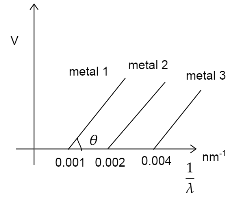
The graph between

A. Ratio of work functions
B. Ratio of work functions
C.
D. The violet colour light can eject photoelectrons from metal

Answer
486.9k+ views
Hint: Here we will use Einstein’s photoelectric equation. From that equation we will see how the graph between stopping potential and
Formula used:
Complete step by step answer:
If
If we compare this equation with the equation of a straight line
Thus the option C is correct.
Again the equation
Now from the graph we have
So the option A is correct.
Now violet has the wavelength
Thus from the graph we can see
So option D is also incorrect.
So, the correct answer is “Option A and C”.
Note: Here we need to know about the photoelectric effect. We need to modify Einstein's photoelectric equation in different forms according to the question to be answered. An incident radiation can only eject electrons from a metal if its frequency is greater than some minimum value called the threshold frequency.
Formula used:
Complete step by step answer:
If
If we compare this equation with the equation of a straight line
Thus the option C is correct.
Again the equation
Now from the graph we have
So the option A is correct.
Now violet has the wavelength
Thus from the graph we can see
So option D is also incorrect.
So, the correct answer is “Option A and C”.
Note: Here we need to know about the photoelectric effect. We need to modify Einstein's photoelectric equation in different forms according to the question to be answered. An incident radiation can only eject electrons from a metal if its frequency is greater than some minimum value called the threshold frequency.
Recently Updated Pages
Master Class 9 General Knowledge: Engaging Questions & Answers for Success

Master Class 9 English: Engaging Questions & Answers for Success

Master Class 9 Science: Engaging Questions & Answers for Success

Master Class 9 Social Science: Engaging Questions & Answers for Success

Master Class 9 Maths: Engaging Questions & Answers for Success

Class 9 Question and Answer - Your Ultimate Solutions Guide

Trending doubts
Give 10 examples of unisexual and bisexual flowers

Draw a labelled sketch of the human eye class 12 physics CBSE

Differentiate between homogeneous and heterogeneous class 12 chemistry CBSE

Differentiate between insitu conservation and exsitu class 12 biology CBSE

What are the major means of transport Explain each class 12 social science CBSE

a Tabulate the differences in the characteristics of class 12 chemistry CBSE




